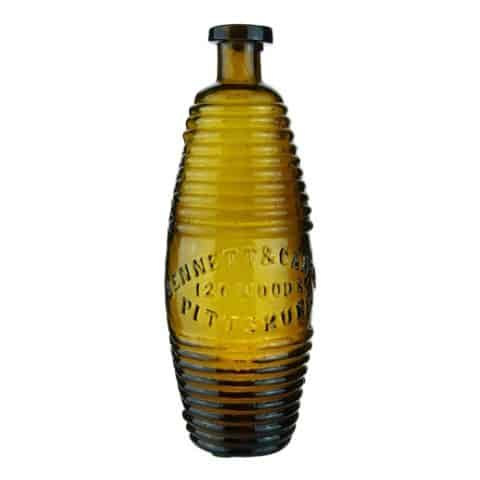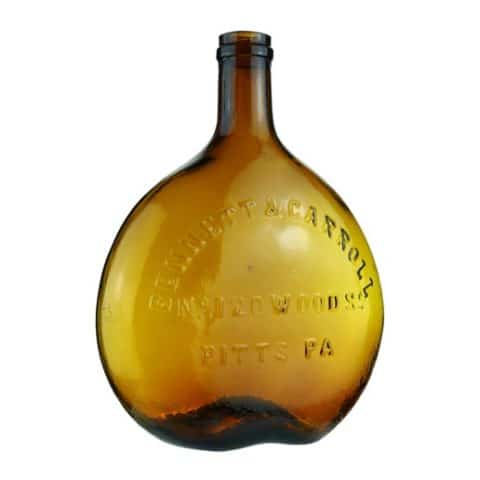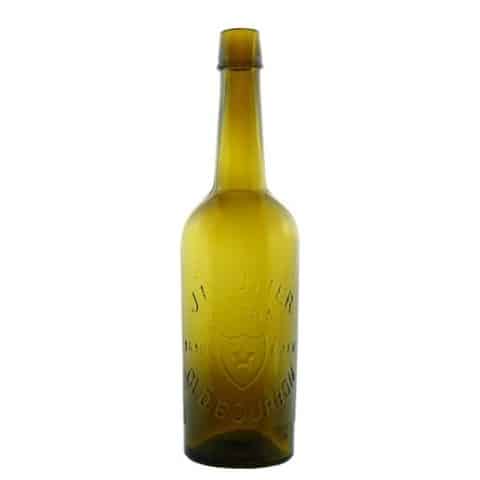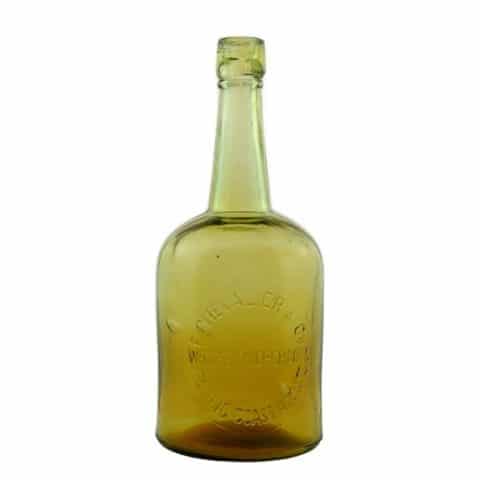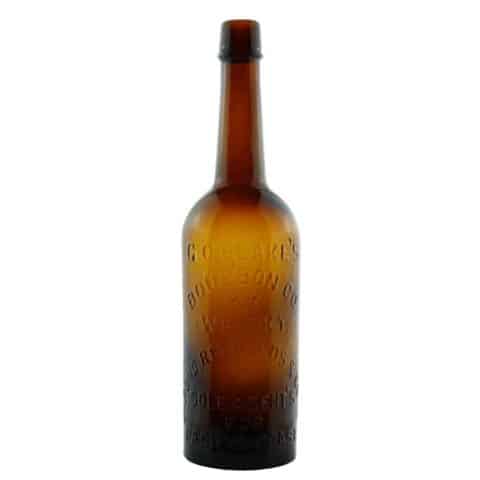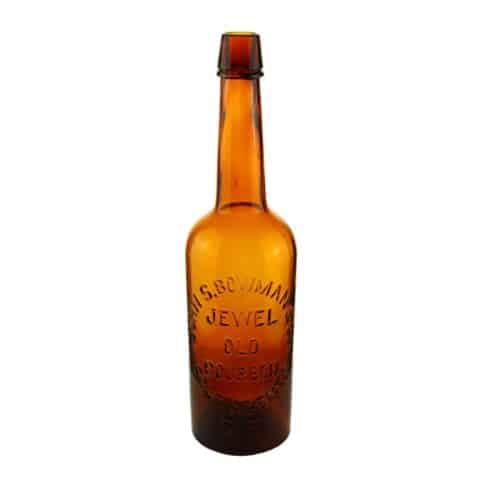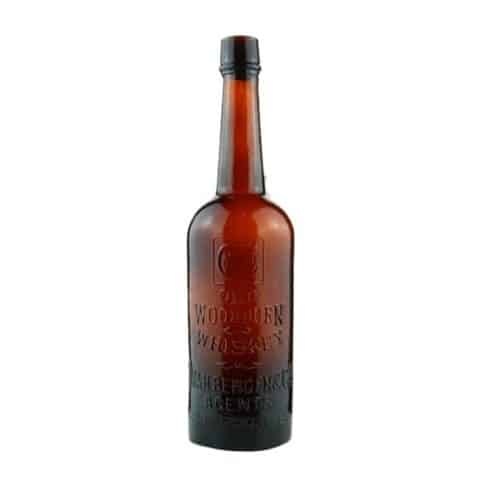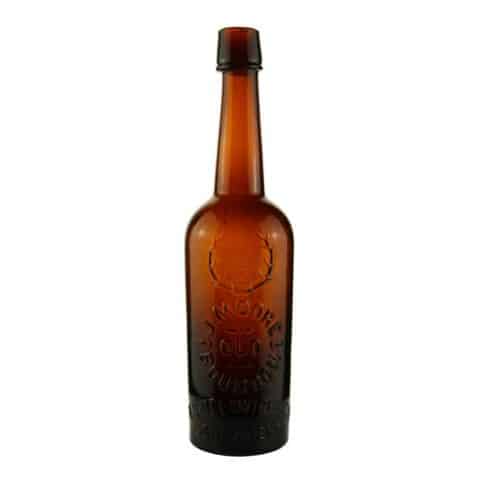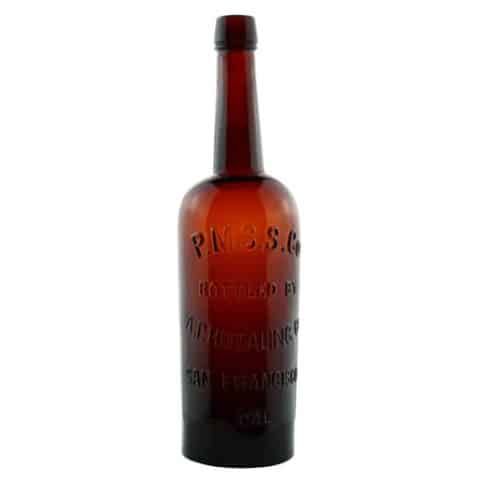London Jockey Clubhouse Gin
London Jockey Club house Gin
Misspelled “HUOSE” Variant
Embossed Rider on Running Horse
Alfred E. & Charles E. Tilton, New York
Apricot Copper Fancy Square
Provenance: Michael George Collection

This exciting London Jockey Club House Gin bottle with the embossed rider on a running horse is steeped in history and a favorite with collectors, especially Westerners. With a great name, eye appeal, glass character, and glass colors, examples are cherished. What makes this example more intriguing is the error with the misspelling of “House.”

Each word in the London Jockey Club House Gin name has meaning. “London” refers to the London-style Dry Gin that the brand was based. London Dry Gin was extremely popular in London, England, in the 1780s and is still the number one Gin sold today. The “Jockey Club” was founded in 1750 as one of the most exclusive high society social clubs in the United Kingdom. It was also the primary organization in British horse racing. “House Gin” refers to a Jockey Club which had a clubhouse in Pall Mall, London, where many other gentlemen’s clubs were based. Each clubhouse had a house drink. The Jockey Clubs’ house drink was a Gin cocktail.

Our subject apricot-copper-amber bottle is square with beveled corners and tall arched side panels gracefully connecting to the shoulder and neck. The mouth has an applied double tapered collar. There is a pronounced iron pontil, and the bottle height is approximately 9 3/8 inches. The first side panel is embossed ‘LONDON JOCKEY’ in a sans-serif typestyle in two centered lines reading vertical shoulder to base. The second panel reads ‘CLUB HUOSE’ (sic) ‘GIN’ in a similar manner. The third panel pictures the embossed rider, a jockey, on a running horse. The fourth blank panel would have been where a paper label would have been applied. The bottle can be found in an astounding array of glass colors and a number of variant molds. This example is about as good as it gets. Two examples have been reported.

Alfred E. Tilton was born on November 11, 1815, in New Hampshire. His younger brother Charles E. was born on September 14, 1827, also in New Hampshire. In the mid-1840s, Alfred’s company had business in California shipping imported wines and spirits, working as Tilton & Molony, located at 58 Water St. in New York. With word of the Gold Rush, younger brother Charles, having learned how to speak Spanish, sailed to California early in 1849 and ventured into business with Newhall, Ladd, and Patrick.
In 1855, M. S. Molony left Tilton & Molony, and Alfred had his younger brother Charles join him under the new banner A. E. & C. E. Tilton. They were located at 47 Cedar Street in New York from 1855 to 1874 and were involved in many businesses, including importing wines and spirits, hardware, fireproof safes, and banking. They also invested in railroads, liquor distilleries, and a New Jersey glass company. The brothers had become a highly profitable company with a well-respected name.
London Jockey Club House Gin was the Tildon Bro’s leading import product. Their newspaper ads said it was “For sale by the principal Grocers and Druggists throughout the U.S. being endorsed by all eminent physicians as containing superior medicinal properties.”

James Patrick & Co. in San Francisco became the Sole Agent for Tilton’s London Jockey Club House Gin from January 1859 to 1864. Patrick started in California sometime in 1849 and was listed in the 1850 San Francisco directory as a liquor dealer on Clay Street. He would eventually move to Battery Street, as seen in the 1858 advertisement below.

In August 1858, the Tilton Brothers sent a communication to James Patrick in San Francisco saying, “We are introducing a new article of Gin to the California market. A new fancy style gin bearing the name “London Jockey Club House Gin.” This Gin is foreseen to be a higher quality taste than all on the market today. Enclosed are samples of said Gin for your use. The arrival of shipments in next few months per ship Storm King — A. E. & C. E. Tilton, New York“
A found ledger from the company indicated that sailing ships departed New York and delivered London Jockey Club House Gin to 35 well-known western companies such as Booth & Co., H. Brickwedell & Co., E. G. Lyons, John Van Bergen & Co., and A. P. Hotaling & Co. These trips took anywhere from 125 days to 180 days to make it from New York to California. Most of these companies were located in San Francisco and Sacramento. Surviving records indicate that 8,000 cases were shipped to California at one point, with 500 cases going on to Hawaii and 500 cases delivered to Colorado from California by train. The Gin sold at $4.75 to $5.00 per case, with 12 bottles per case. In total, 96,000 bottles were sold and shipped to the West. Some projections suggest that 100,000 bottles of London Jockey Club House Gin were produced from 1858 to 1864 and sold in the United States.
A follow-up letter from Patrick to the Tilton Bro’s mentions London Jockey’s slow start in California’s Gin market. “June 18, 1859, To A. E. & C. E. Tilton, New York—We are progressing favorably with sales. It takes time to introduce a new article of Gin. Especially as there are so many brands to compete with, but so far we have no reason to appear otherwise than encouraged at the aspects of doing a fair share of the business in house gins in the market.”
August 1859 seemed to be the pinnacle of success and popularity as London Jockey Club House Gin became the most requested Club House Gin on the market for the next two years even though there was competition from brands like J. T. Daly, Booth & Sedgewick, Voldner’s, Udolpho Wolfe’s, and case style gins like Wistar’s Club House. In November 1859, auction merchants paid $3.25 a case for Voldner’s Schnapps and $4.75 a case for the London Jockey Club House Gin, indicating that merchants were willing to pay more for the London Jockey Gin because of its quality taste. Other reports mention a fair taste competition with the London Jockey beating all other brands. The popularity of this Gin would continue thru 1860.
In 1861 sales dropped due to the outbreak of the Civil War, and shipments from New York were cut in half. Some states like Colorado were cut off entirely and relied on California merchants shipping the Gin by train. Also, the demand for American whiskies was on the rise in the West. The Tilton Bro’s saw this and had their own brand of whiskey distilled in Ohio, called Black Horse Whiskey.
By October 1862, London Jockey was holding firm as other brands were being taken off the market due to the increased demand for whiskey. After 1864, the gin market ended, with whiskey dominating the Western market until prohibition.

Primary Image: London Jockey Club House Gin error bottle imaged on location by Alan DeMaison, FOHBC Virtual Museum Midwest Studio
Support: Reference to Tilton Bro’s London Jockey Club House Gin by Mike McKillop, Antique Bottle & Glass Collector
Support: Museum example London Jockey Club House Gin error bottle in window, photograph by Michael George
Support: Slide show examples of London Jockey Club House Gin bottles photographed by Ferdinand Meyer V.
Support: Reference to The transposed London Jockey Club Huose (Club House) Gin, October 2012, Peachridgeglass.com
Support: Reference to London Jockey Club House Gin, April 2012, Peachridgeglass.com
Join the FOHBC: The Virtual Museum is a project of the Federation of Historical Bottle Collectors (FOHBC). To become a member.
Join the FOHBC: The Virtual Museum is a project of the Federation of Historical Bottle Collectors (FOHBC). To become a member.






